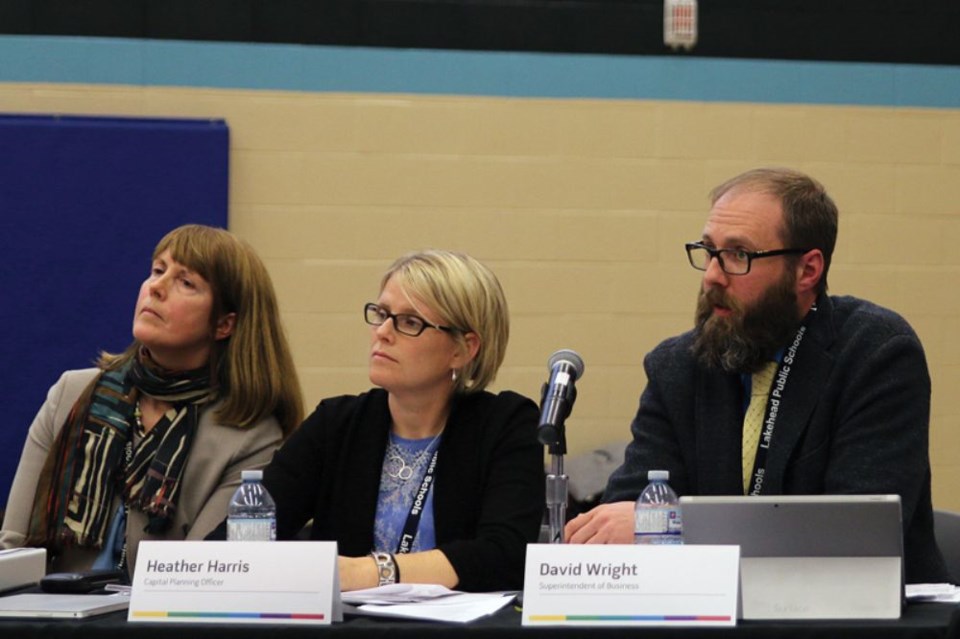THUNDER BAY – If the first public meeting is any indication, the future of the city’s two public north side high schools is going to spark spirited debate until a final decision is made.
A few hundred people were in attendance in the Superior Collegiate and Vocational Institute gymnasium Monday night to learn about the Lakehead Public School Board’s north side renewal plan and voice their opinions and ask questions.
That plan presents the board of trustees with two proposed options.
The first would shutter Hammarskjold High School with Superior receiving an addition to accommodate all north side students. In addition, St. James Public School and C.D. Howe Public School would both close with those students relocating to an expanded Vance Chapman Public School. The capital construction cost of those expansions is pegged at $8.7 million, while the closures will save $5.2 million in expected facility renewal costs.
The second option is to keep Hammarskjold open as the lone secondary school, transforming Superior into an elementary school. That would result in the closures of St. James, C.D. Howe and Vance Chapman. That comes with a $7 million capital construction cost and facility renewal savings of $3 million.
That plan, which also includes the closure of Sir Winston Churchill and Collegiate and Vocational Institute on the south side, was first announced publicly in February and will be voted on in October. It is the result of plummeting enrollment that has left nearly 4,000 empty pupil spaces across the city and the provincial government phasing out top-up funding for unfilled seats within the next three years.
Even though trustees can decide to keep all of the schools open, it seemed many in the audience at both the north side meeting and last week’s south side meeting view it as a foregone conclusion two high schools will close.
At the meeting there was support from both Hammarskjold and Superior supporters on why their school should be the one left as the one high school.
Amanda Gollat, a recently graduated Superior student, said the soon to be eight-year-old school, which was built at a cost of $32.8 million, offers the best learning environment for secondary students.
She spoke multiple times at the meeting, describing her time at the school and questioning whether perceived shortcomings such as a small parking lot or lack of greenspace should factor into the decision.
“It’s really great you have the opportunities to do whatever you want. I had a friend who came into here thinking she was going into engineering but then she took a welding class and wants to go into welding,” she said.
“We should be focused on the education of students, not the size of our parking lot because that doesn’t affect our education in any way.”
Several people who spoke at the meeting expressed concern with sending small children to Superior, a school built for teenagers and young adults.
However Mike Judge, president of the Lakehead Elementary Teachers Federation of Ontario, said the union is unanimously in favour of converting Superior into an elementary school.
He pointed to Ecole Gron Morgan, a former high school that now functions as an elementary school, as an example of where a bigger school has been successfully retooled.
“We certainly see Option 2 as a real opportunity for the board to grow our board, make it stronger and of course that translates into more students and more jobs and job security for my members,” Judge said.
While many of the people at the meeting who favoured keeping Superior a high school considered amenities for specialized programs as a waste if the school transitioned, Judge sees the opposite.
“The opportunity to provide a full rotary program in our intermediate divisions in a larger school presents great opportunities in terms of the programming,” Judge said.
“It’s more difficult to do in a single track K-8 school where you don’t have the numbers and the staff to offer that full rotary program. In this particular school, it would be a real drawing card in my opinion when you could offer a return to some sort of shops program, arts and music program.”
Others spoke about the quality of programming and space at Hammarskjold, which wouldn’t require an addition but would need some renovations.
Parents and students had questions ranging from transitions for special needs students, accommodations for specialty programs that would be moved and ensuring extracurricular opportunities remain available.
Colleen Kappel, superintendent of education and chair of north side accommodation review committee, said if trustees vote to go ahead with closures a transition committee will be struck to help make the process to amalgamate the schools as smooth as possible.
She also said contingency plans are in place if construction is delayed.
In the meantime, the renewal plan is already hanging around like a dark cloud.
Gollat has heard from current students that the public Hammarskjold versus Superior fight is taking a toll.
“It’s been just a headache. This is distracting from school,” she said. “We could be focusing on much more important things and instead students are forced to be put into adult situations.”
Another public meeting will be held in June.
